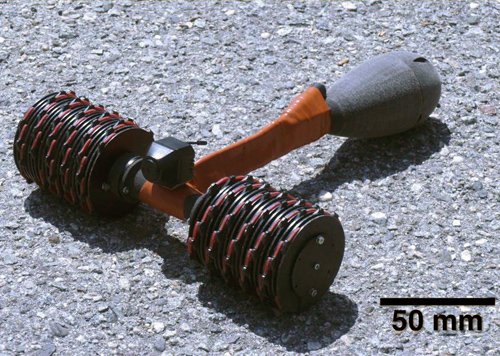
The Durable Reconnaissance and Observation Platform (DROP).
The objective of this task is to expand the mobility capabilities of reconnaissance robots. We are specifically targeting climbing and the transitions between horizontal and vertical surfaces (and vice versa) using two attachment technologies, microspines for rough surfaces, and fibrillar adhesives for smooth surfaces. The Durable Reconnaissance and Observation Platform (DROP) is shown here, which can climb near-vertical surfaces and survive falls from three meters. This is a two-wheeled robot using rotary microspines to transition from flat ground to near-vertical walls, and has a climbing speed of 25 cm/s and ground speed of 45 cm/s.
We invented a new rotary microspine that uses 4 steel hooks embedded in a rigid frame connected by soft, elastic flexures. This architecture simplifies climbing because a single motor can be spun continuously, rather than having to servo a leg through a precise trajectory sacrificing speed to the constant alteration of the inertia of the leg.
A similar platform is in development using gecko-like fibrillar adhesives. These hairy structures use van der Waals forces to enable adherence that can be activated by the geometry of the fibers and the direction of the force being applied, a very desirable property for a wall-climber. The adhesives will theoretically function similarly in space because van der Waals forces are not very sensitive to temperature and vacuum.


